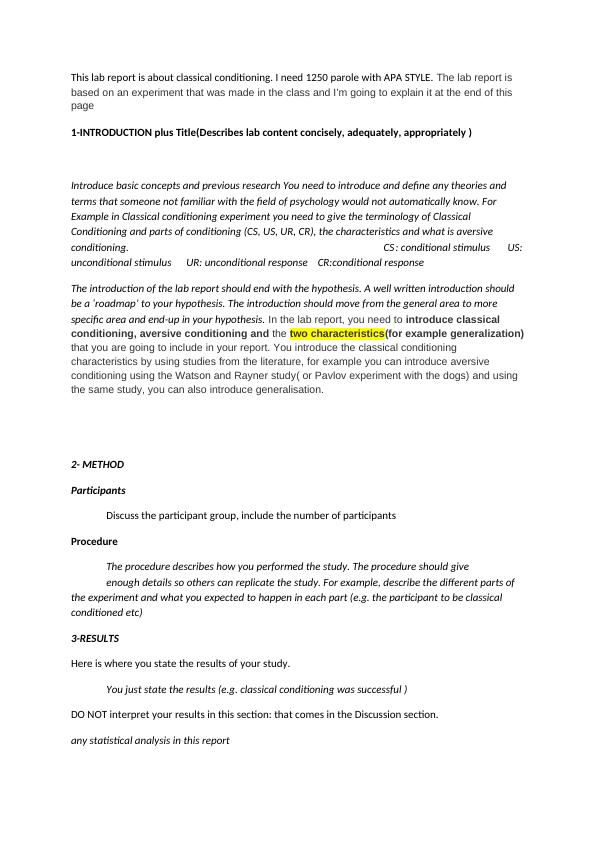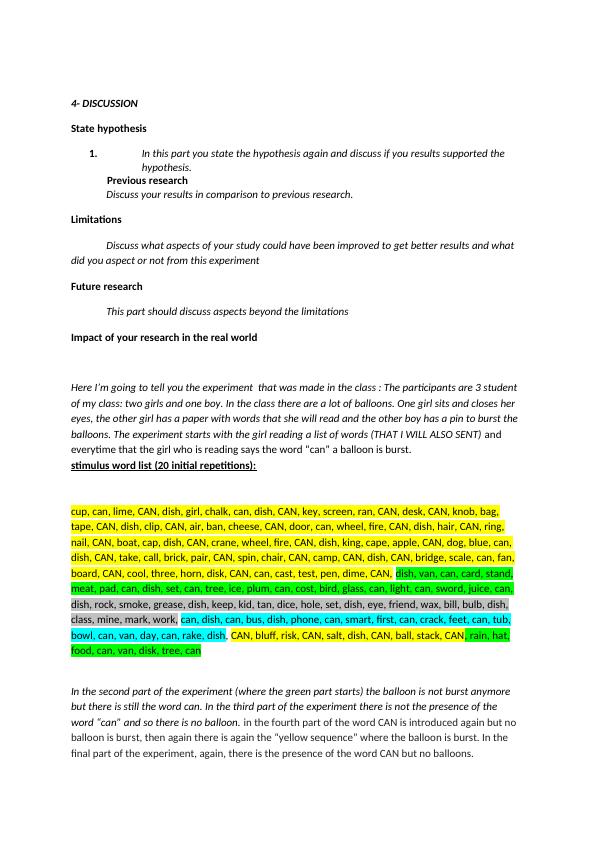Ask a question from expert
Report on Classical Conditioning
4 Pages1129 Words767 Views
Added on 2019-10-18
Report on Classical Conditioning
Added on 2019-10-18
BookmarkShareRelated Documents
This lab report is about classical conditioning. I need 1250 parole with APA STYLE. The lab report is based on an experiment that was made in the class and I’m going to explain it at the end of this page 1-INTRODUCTION plus Title(Describes lab content concisely, adequately, appropriately )Introduce basic concepts and previous research You need to introduce and define any theories and terms that someone not familiar with the field of psychology would not automatically know. For Example in Classical conditioning experiment you need to give the terminology of Classical Conditioning and parts of conditioning (CS, US, UR, CR), the characteristics and what is aversive conditioning. CS: conditional stimulus US:unconditional stimulus UR: unconditional response CR:conditional response The introduction of the lab report should end with the hypothesis. A well written introduction should be a ‘roadmap’ to your hypothesis. The introduction should move from the general area to more specific area and end-up in your hypothesis. In the lab report, you need to introduce classical conditioning, aversive conditioning and the two characteristics(for example generalization)that you are going to include in your report. You introduce the classical conditioning characteristics by using studies from the literature, for example you can introduce aversive conditioning using the Watson and Rayner study( or Pavlov experiment with the dogs) and using the same study, you can also introduce generalisation.2- METHODParticipantsDiscuss the participant group, include the number of participants ProcedureThe procedure describes how you performed the study. The procedure should give enough details so others can replicate the study. For example, describe the different parts of the experiment and what you expected to happen in each part (e.g. the participant to be classical conditioned etc)3-RESULTSHere is where you state the results of your study.You just state the results (e.g. classical conditioning was successful )DO NOT interpret your results in this section: that comes in the Discussion section.any statistical analysis in this report

4- DISCUSSIONState hypothesis1.In this part you state the hypothesis again and discuss if you results supported the hypothesis. Previous researchDiscuss your results in comparison to previous research.LimitationsDiscuss what aspects of your study could have been improved to get better results and what did you aspect or not from this experiment Future research This part should discuss aspects beyond the limitationsImpact of your research in the real world Here I’m going to tell you the experiment that was made in the class : The participants are 3 student of my class: two girls and one boy. In the class there are a lot of balloons. One girl sits and closes her eyes, the other girl has a paper with words that she will read and the other boy has a pin to burst the balloons. The experiment starts with the girl reading a list of words (THAT I WILL ALSO SENT) and everytime that the girl who is reading says the word “can” a balloon is burst. stimulus word list (20 initial repetitions):cup, can, lime, CAN, dish, girl, chalk, can, dish, CAN, key, screen, ran, CAN, desk, CAN, knob, bag, tape, CAN, dish, clip, CAN, air, ban, cheese, CAN, door, can, wheel, fire, CAN, dish, hair, CAN, ring, nail, CAN, boat, cap, dish, CAN, crane, wheel, fire, CAN, dish, king, cape, apple, CAN, dog, blue, can, dish, CAN, take, call, brick, pair, CAN, spin, chair, CAN, camp, CAN, dish, CAN, bridge, scale, can, fan, board, CAN, cool, three, horn, disk, CAN, can, cast, test, pen, dime, CAN,dish, van, can, card, stand, meat, pad, can, dish, set, can, tree, ice, plum, can, cost, bird, glass, can, light, can, sword, juice, can,dish, rock, smoke, grease, dish, keep, kid, tan, dice, hole, set, dish, eye, friend, wax, bill, bulb, dish, class, mine, mark, work,can, dish, can, bus, dish, phone, can, smart, first, can, crack, feet, can, tub, bowl, can, van, day, can, rake, dish, CAN, bluff, risk, CAN, salt, dish, CAN, ball, stack, CAN, rain, hat, food, can, van, disk, tree, canIn the second part of the experiment (where the green part starts) the balloon is not burst anymore but there is still the word can. In the third part of the experiment there is not the presence of the word “can” and so there is no balloon. in the fourth part of the word CAN is introduced again but no balloon is burst, then again there is again the “yellow sequence” where the balloon is burst. In the final part of the experiment, again, there is the presence of the word CAN but no balloons.

End of preview
Want to access all the pages? Upload your documents or become a member.
Related Documents
Unconditional and Natural Responselg...
|7
|1775
|186
Learning to dislike alcohol: conditioning negative implicit attitudes toward alcohol and its effect on drinking behaviourlg...
|4
|1123
|299